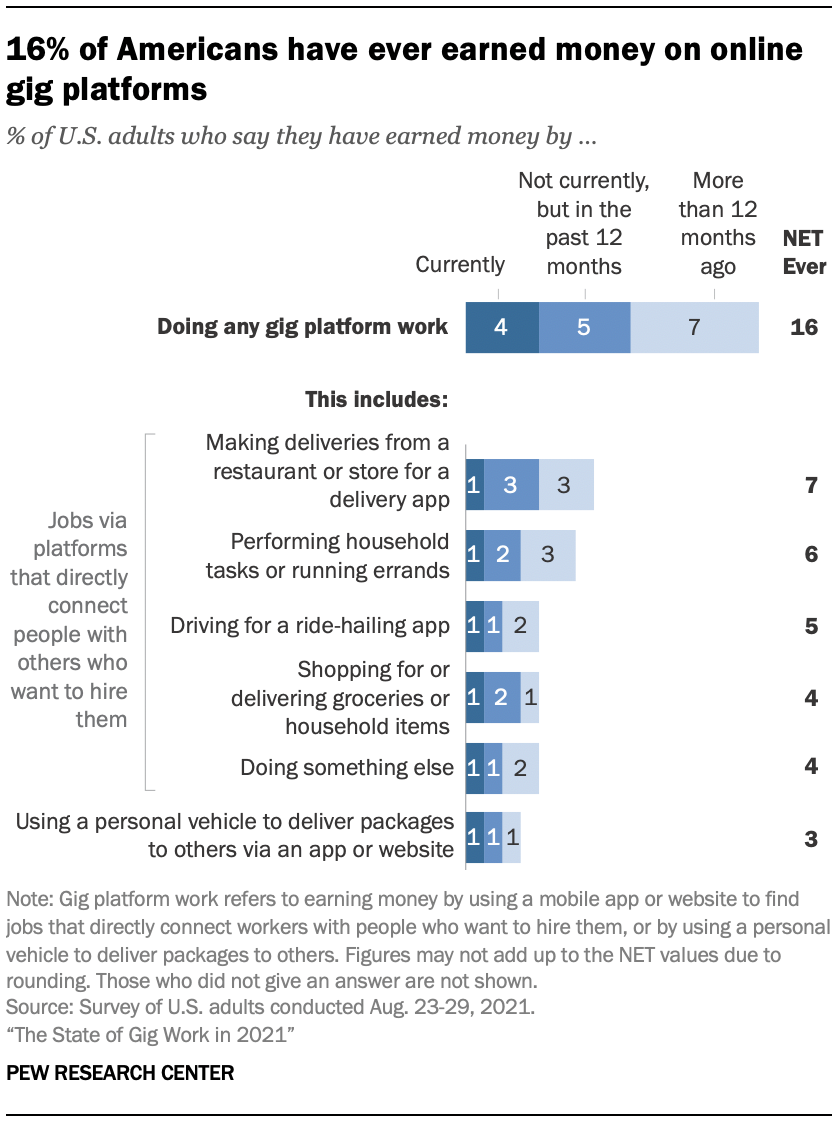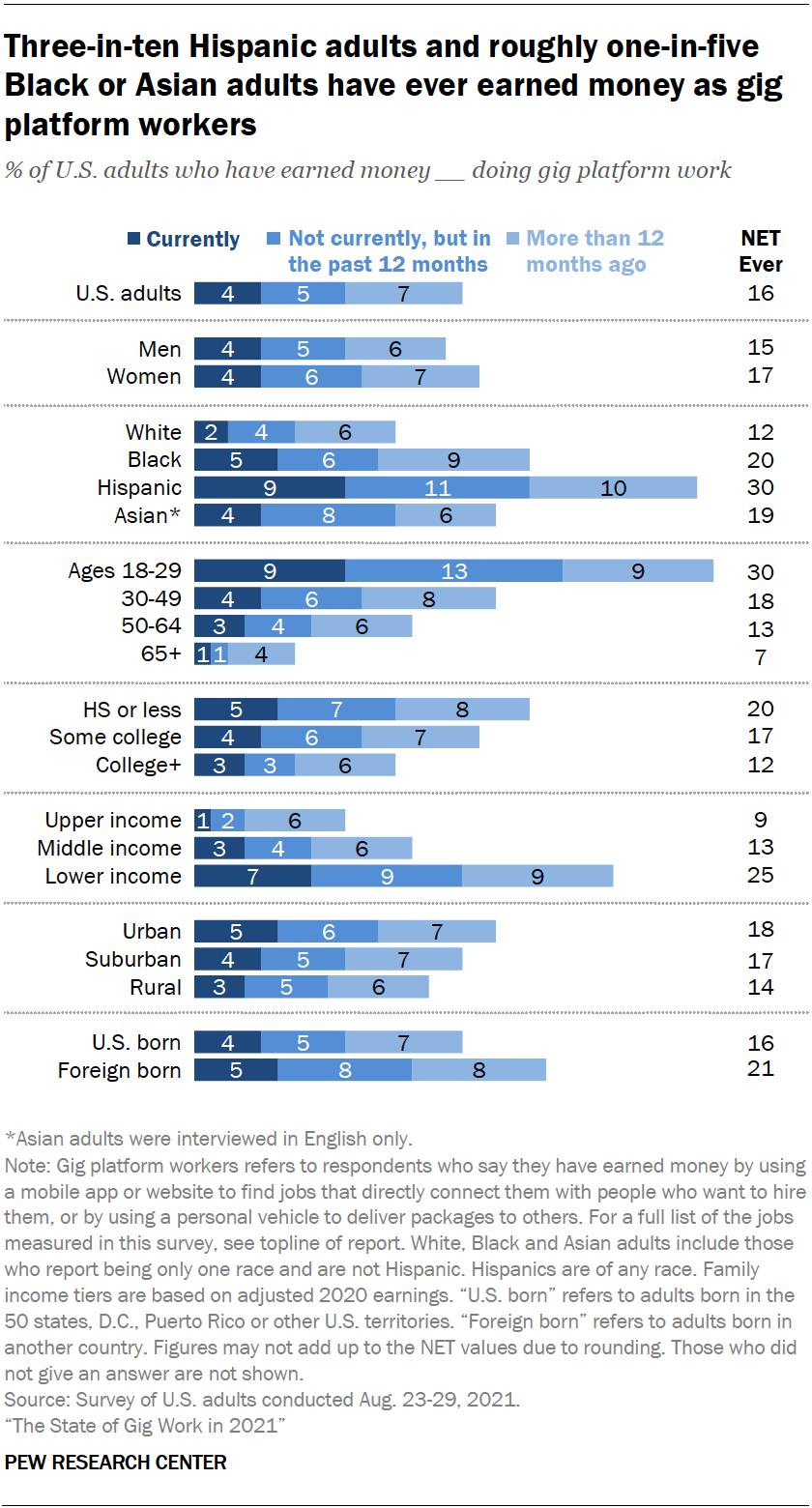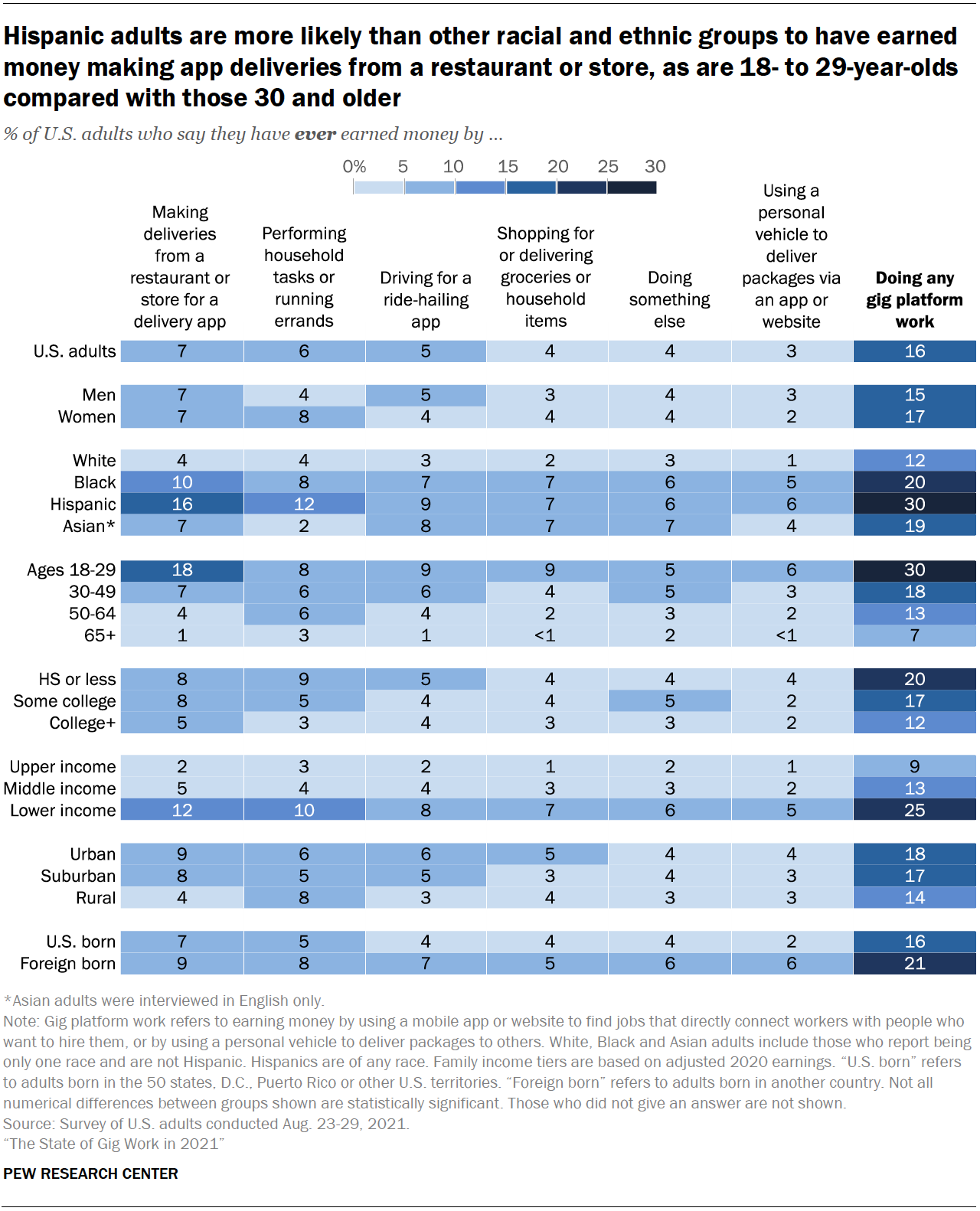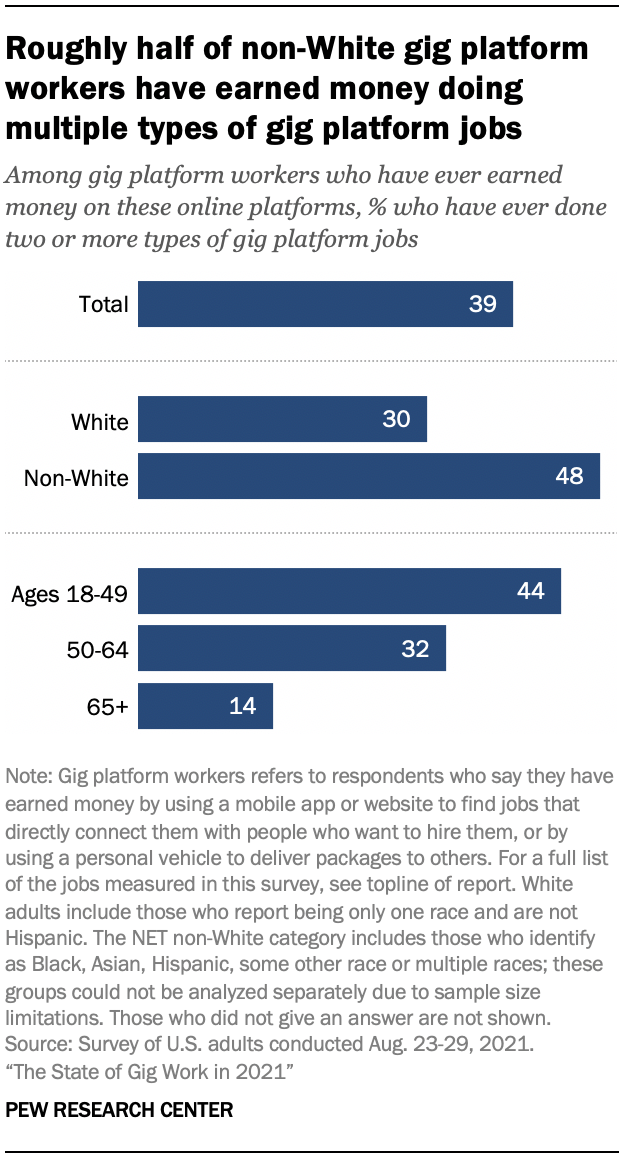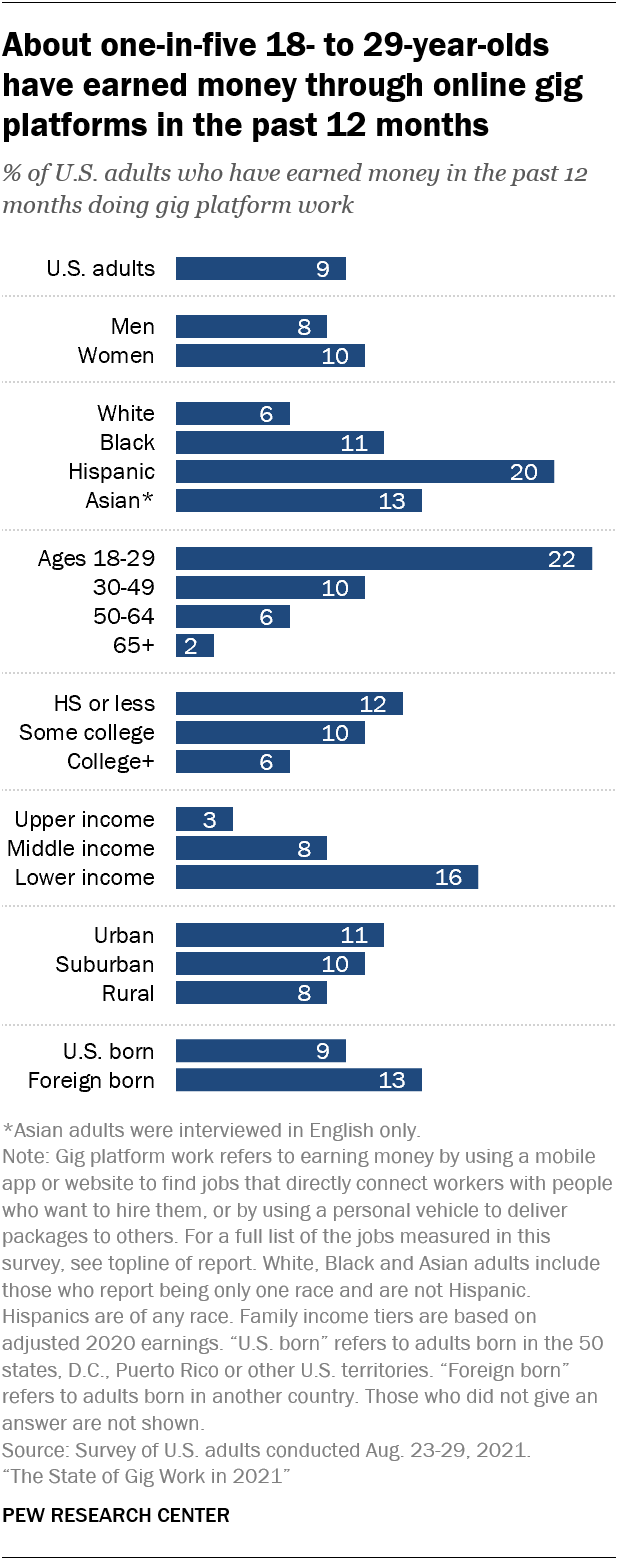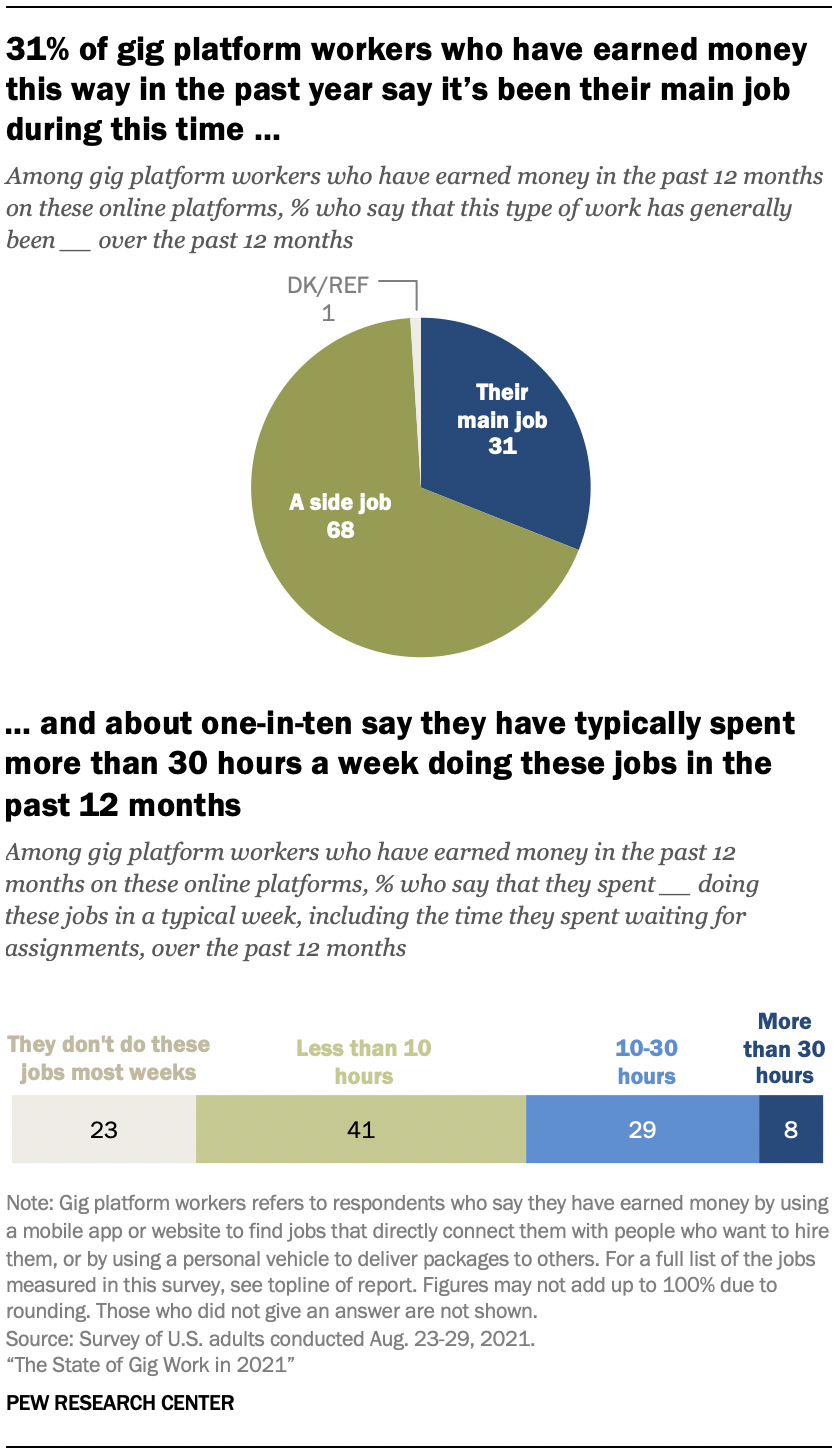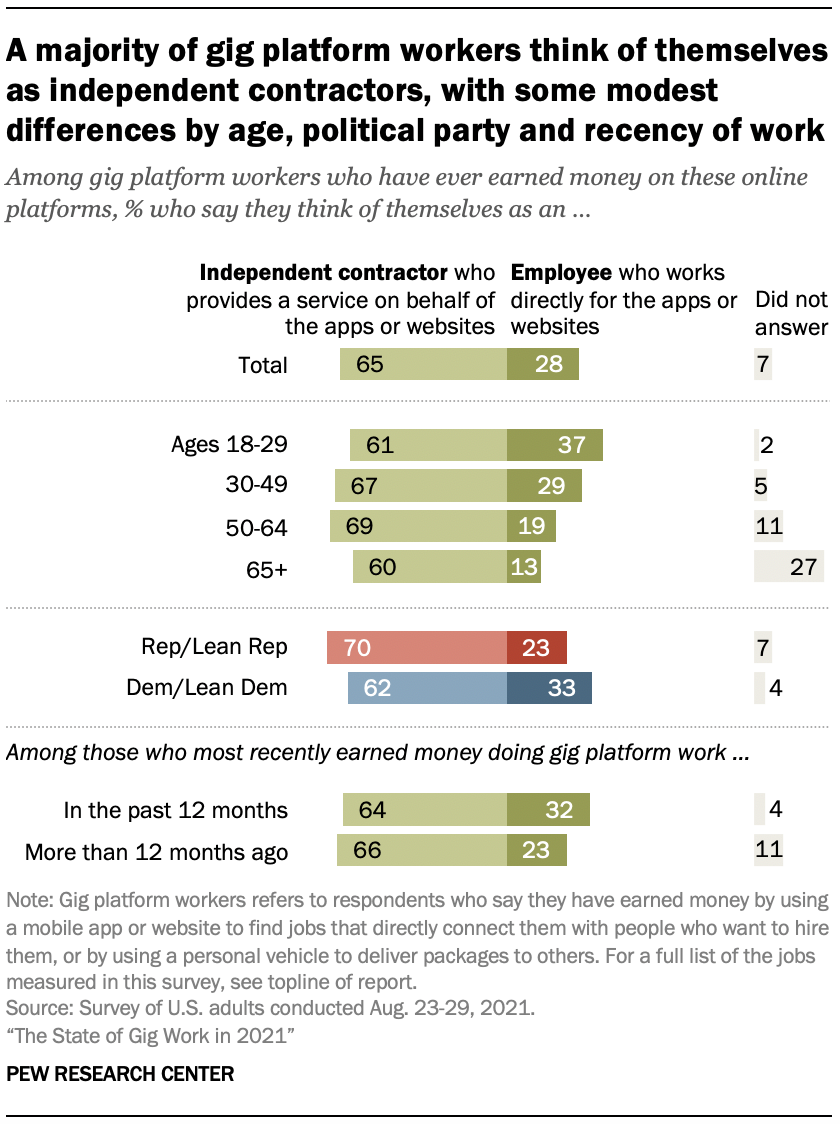As online services reshape how Americans go about their lives and tech developments mold the future of work, the rise of digital “gig platforms” has transformed how some people find jobs. From ride-hailing companies to services enabling deliveries of packages, groceries or restaurant meals, to apps connecting people with others who can help them complete errands, a rapidly evolving landscape has provided new ways for Americans to earn money.
Some 16% of U.S. adults have ever earned money by doing jobs via these platforms, and this group has some notable demographic characteristics: Adults under age 30, Hispanic adults and those with lower household incomes are particularly likely to have earned money in this way.
When examining how these workers see their platform jobs, about three-in-ten of those who have done gig platform work in the past year say it has been their main job; at the same time, the largest share of gig workers – about four-in-ten – say they have worked less than 10 hours in a typical week. And when it comes to how they think about their relationship with the companies that run these platforms, those who have ever done this work are more likely to see themselves as independent contractors than as employees.
16% of Americans have earned money on gig platforms at some point
In order to understand how common this kind of work is in the U.S., the Center asked Americans in August 2021 about their experience earning money through the following types of gig platform jobs: driving for a ride-hailing app (such as Uber or Lyft); shopping for or delivering groceries or household items (such as Instacart or Peapod); performing household tasks like cleaning someone’s home or assembling furniture, or running errands like picking up dry cleaning (such as TaskRabbit or Angi); making deliveries from a restaurant or store for a delivery app (such as DoorDash or UberEats); using a personal vehicle to deliver packages to others via a mobile app or website such as Amazon Flex; or doing something else on a gig app or website.
In all, 16% of Americans have ever earned money doing gig platform work in at least one of these ways. About one-in-ten adults (9%) have earned money doing gig platform work in the past 12 months, including 4% who were doing so currently when the survey was conducted. On the other hand, 7% report that it has been more than a year since they have done this work.
When it comes to specific types of jobs, about one-in-ten or fewer adults have ever earned money in each category. Some 7% say they have made deliveries from a restaurant or store for a delivery app, 6% have performed household tasks or ran errands via a gig platform and 5% have driven for a ride-hailing app. Small shares also report ever shopping for or delivering groceries or household items (4%) or using a personal vehicle to deliver packages to others via an app or website (3%). And among the 4% who indicate they have done something else to earn money from these types of mobile sites or apps, the most common type of work mentioned is completing surveys, online tasks or other research activities.
Looking at those who have done gig platform work in the past year, only small shares of Americans have earned money in this way. For example, 4% of Americans say they have made deliveries from restaurants or stores for delivery apps in the past 12 months, including just 1% of Americans who say they were currently doing so as of the August 2021 survey. And 2% report that they have driven for a ride-hailing app in the past 12 months.
Americans’ experience with earning money through gig platforms varies by age, race, ethnicity and income
Earning money on online gig platforms varies by a number of demographic characteristics – including by race and ethnicity, age, household income, formal educational attainment, community type and country of birth.
There are large differences by race and ethnicity. Hispanic adults are more likely than other racial and ethnic groups to have earned money in this way – 30% have done so, compared with 20% of Black adults, 19% of Asian adults and even smaller shares of White adults (12%).
Young adults are also more likely to have done so than older adults – 30% of those ages 18 to 29 have ever earned money on gig platforms, compared with 18% of 30- to 49-year-olds. Smaller shares of those ages 50 and older say the same.
And even when looking at adults under age 50, racial and ethnic differences in doing gig platform work persist. Among adults ages 18 to 49, Hispanic (34%) and Black (27%) adults are more likely to have earned money on these gig platforms compared with White adults in this same age range (16%).5
People’s experiences with gig platform work also vary by household income. A quarter of Americans with lower household incomes say they have ever earned money doing gig platform work, compared with about one-in-ten of those who have middle or upper incomes.
Finally, there are smaller differences by where someone lives and their country of birth. Those living in urban or suburban areas are slightly more likely than those living in rural communities to have earned money on gig platforms. And those born outside the U.S. are somewhat more likely than those born in the U.S. to say this (21% vs. 16%).6
Similar patterns stand out when looking at individual types of gig platform work, especially when it comes to age, race and ethnicity, and income – but there is some variation across individual jobs.
Differences among demographic groups are particularly pronounced when it comes to using a gig app to make deliveries from a restaurant or store. The share of adults under age 30 who have ever done so is higher than that of any other age group – an 11-point difference compared with adults ages 30 to 49, for example.
Hispanic Americans are also more likely than other racial and ethnic groups to say they have earned money making these deliveries – a 12-point difference compared with White adults and 9 points compared with Asian adults. Black adults are less likely than Hispanic adults, but more likely than White adults, to have done so. And when it comes to household income, those with lower incomes are more likely than adults with middle or upper incomes to say they have ever earned money in this way.
By comparison, Hispanic, Black and Asian adults are similarly likely to have earned money driving for ride-hailing apps – but each of these groups is more likely than White adults to have done so. Adults under age 50 are more likely to have earned money as a ride-hailing driver compared with smaller shares of those 50 and older. And those with lower incomes are more likely than those with middle or upper incomes to report the same.
Some workers have earned money across multiple types of gig platform jobs. Among gig platform workers who have ever earned money in this way, 61% have done exactly one of the types of work the survey explored, while 39% have earned money in two or more ways.
Doing multiple types of gig platform jobs is more prevalent among workers ages 18 to 49 compared with those 50 and older: 44% of gig platform workers under 50 fall into this group, compared with 32% of those ages 50 to 64 and even smaller shares of those 65 and older.
Gig platform workers who do not identify as White are also more likely than those who do identify in this way to have earned money via multiple types of gig jobs (48% vs. 30%).
Among those who have ever driven for ride-hailing apps, about six-in-ten (57%) also say they have earned money making deliveries from a restaurant or store for a delivery app. About four-in-ten ride-hailing drivers (37%) say that they have also earned money shopping for or delivering groceries or household items. These patterns reflect companies’ shifts during the pandemic and more generally as ride-hailing platforms have expanded their offerings.
Among the 9% of Americans who have earned money through gig platforms in the past year, about three-in-ten say it has been their main job during this time
The coronavirus outbreak prompted a number of changes for platforms as well as their workers – especially as fluctuating demand for services like food delivery and ride-hailing caused some companies to pivot their operations. At the same time, the economic impacts of the pandemic also left some gig workers struggling to make ends meet.
Amid these rapidly changing circumstances, the Center explored the characteristics and experiences of the 9% of Americans who said in the August 2021 survey that they had earned money on gig platforms in the past year. This group is referred to as current or recent gig workers throughout this report.
The demographic characteristics of these current or recent gig workers are largely similar to those who have ever done this work, both for individual types of jobs and for this work overall. For example, adults under age 30 are more likely than any other age group to say they have earned money in this way during the past 12 months.
The racial and ethnic makeup of current or recent gig workers also mirrors those who have ever earned money in this way. Hispanic adults are more likely than any other racial or ethnic group to have done gig work in the past year; their White counterparts are the least likely among the racial and ethnic groups studied to report the same. Americans with lower incomes are also more likely than those with middle or upper incomes to be current or recent gig workers.
The survey also aimed to understand how these current or recent gig workers think about their work lives: Are the jobs their primary employment or a “side gig,” and how many hours do they spend doing these jobs in a typical week?
Among current or recent gig workers, 31% say this type of work has generally been their main job over the past year. Still, it is far more common for those who do this type of work to classify it as a side job: 68% describe it in this way.
At the same time, some of these workers spend a notable amount of hours on these jobs. About three-in-ten current or recent gig workers say they spent 10 to 30 hours doing these jobs in a typical week over the past year, including the time they spend waiting for assignments. Only a small share (8%) say they spent more than 30 hours per week doing this work.
The majority of workers, though, say they either spent less than 10 hours (41%) in a typical week or don’t do these jobs most weeks (23%).
Majority of gig platform workers say they think of themselves as independent contractors
Gig platforms – and especially ride-hailing companies – have been at the center of debate over whether their workers should be considered employees or independent contractors. Companies that operate these apps have fought to retain drivers’ independent contractor status while advocacy groups lobby for employee benefits. The classification and broader issues relating to the debate are being taken up by state ballot proposals and city council votes.
In addition to exploring Americans’ overall views on the employee-contractor debate, the August 2021 survey asked those who had ever done gig platform work whether or not they think of themselves as employees working directly for the apps or websites or as independent contractors providing a service on behalf of the apps or websites.
Some 28% of those who have ever done gig platform work say they think of themselves as employees. Still, a much larger share say they think of themselves as independent contractors. Some 7% of all gig platform workers – and higher shares of some groups – did not provide a response when asked.
While majorities of gig platform workers across groups think of themselves as contractors, there are some differences in views by age and political party. Some 37% of workers ages 18 to 29 and roughly three-in-ten of those ages 30 to 49 (29%) say they think of themselves as employees, compared with smaller shares of workers ages 50 and older.7
Among gig platform workers, Democrats and those who lean toward the Democratic Party are more likely than Republicans and GOP-leaning independents to say they think of themselves as employees (33% vs. 23%).
The majority of gig platform workers also think of themselves as contractors regardless of when they last did this work. However, those who have earned money in this way during the past year are somewhat more likely to think of themselves as employees compared with those who last earned money more than 12 months ago.
